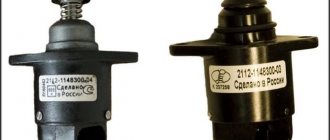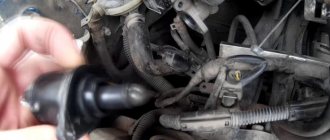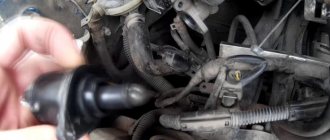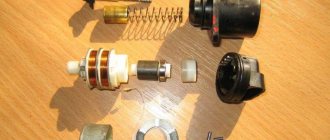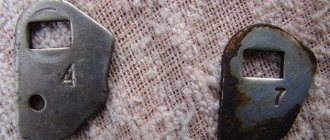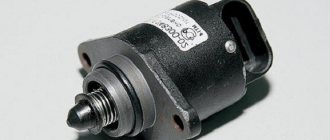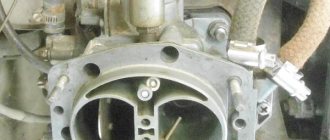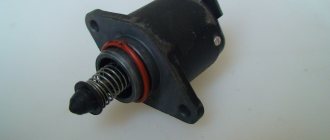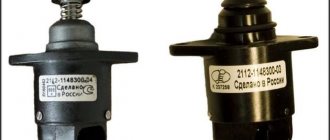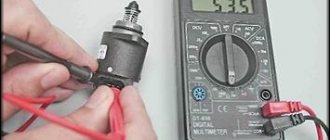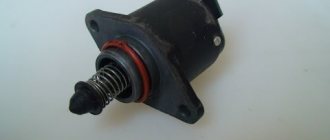In order for the operation of a car engine to be considered impeccable, it is very important to correctly set the initial ignition timing. It is also very important to take care of the correct functioning of the ignition timing regulators. This must be done for the simple reason that incorrectly set ignition timing can subsequently lead to increased fuel consumption, and can also reduce power and lead to engine overheating. And in some situations, incorrectly set ignition timing can even shorten the life of the engine. Therefore, it is so important to know how to set the ignition timing correctly. This useful material will tell you in detail how to perform this operation using a strobe light.
Algoll › Blog › How to work with a strobe
The stroboscope is used to check and adjust the performance of distributor correction systems.
The procedure for working with a strobe light: 1 - warm up the engine, remove the choke, adjust the idle speed to normal or slightly lower, remove the vacuum tube going from the carburetor to the distributor’s “vacuum manifold”. In this mode, we check and adjust the setting of the initial ignition timing. ("classic" - from 2 to 7 degrees, depending on the engine displacement; 08 - 010 - 1100cm - 6 degrees, 1300cm - 1 degree, 1500cm - 4 degrees. Or as in the manual according to vehicle operation).
2 - When the engine speed increases, to approximately 2 thousand, the advance angle should increase by 5 - 7 degrees, if this does not happen, then the centrifugal regulator does not work. The centrifugal mechanism may be jammed, or the springs may be broken.
3 - Checking the operation of the vacuum ignition timing regulator is a little more difficult, since its operation is related to the operation of the carburetor. The main condition for the normal operation of the vacuum corrector is that when the engine is running at idle speed, there should be no vacuum in the tube going from the carburetor to the “vacuum manifold”. A vacuum should appear only when the engine speed increases. The timeliness of the appearance of vacuum in the tube can be checked by applying the tip of the tongue to it (to the end of the tube that we removed at the beginning of the procedure from the “vacuum end” of the distributor). If the carburetor does not ensure the timely appearance of vacuum in the tube, then normal operation of the vacuum corrector is impossible, even with a fully functional distributor mechanism.
If there is a timely vacuum, that is, if the carburetor is working correctly, we proceed to check the functionality of the vacuum regulator itself. We connect the vacuum tube back to the distributor and again “shine the strobe light” on the mark. As the speed increases, the mark should “go” even higher, twice as much as it “went” with the tube disconnected. The total advance angle is the sum of three values - the initial ignition advance angle, plus additional advance created by the centrifugal regulator, plus additional. ahead of the "vacuum man". The total angle can reach 30 degrees, depending on the operating mode of the engine, its model and the characteristics of the distributor.
Ignition distributors have certain, specified operating characteristics; their exact parameters and their compliance with the standard can only be determined on special stands. In our case, we can only determine whether this or that system works at all or not. An experienced master, of course, can “by eye” quite accurately determine the correctness of the operating characteristics of the distributor and correct them, but this requires many years of practical work.
Source
Installation of UOZ with a strobe light
How to use a homemade device to adjust the OZ:
- First you need to start the engine and warm it up to operating temperature. To do this, let the unit run at idle speed.
- Then you will need to connect your homemade device to a power source. This can be either a built-in battery or a car battery.
- Next, a copper sensor should be connected to the core of cylinder 1; to do this, wind it around the core.
- After this, the diode light bulb should be aimed at the mark marked on the housing of the distribution mechanism.
- When these steps are completed, you need to find a fixed point, it is located on the flywheel pulley.
- In order to ensure that these points coincide, you need to rotate the switchgear housing. And when the points coincide, the body must be fixed in this position. When the points match, the diodes should light up.
What is a strobe and why does the engine need it?
Ignition timing is one of the most important parameters that determine engine operation. If you choose the wrong moment of ignition of the fuel-air mixture in gasoline engines or the moment of fuel injection into the combustion chamber in diesel engines, then the engine will work very poorly. As established, ignition and injection must be performed a little earlier than the cylinder reaches top dead center - that is why the parameter is called ignition timing. But why is that?
The fact is that the combustion of any fuel does not occur instantly, but takes a certain period of time, therefore, when the fuel is ignited even before TDC “for real,” it will begin to burn only at TDC, therefore it will transfer the accumulated energy to the piston (in the form of pressure from the expanding exhaust gases). gases) with maximum efficiency. The engine will develop more power and run without interruption.
If you ignite fuel directly at TDC, the piston will not receive all the energy, and engine performance as a whole will be unsatisfactory. But if, on the contrary, you ignite the fuel too early, it will be difficult for the piston to reach TDC due to gas pressure. In some cases, it will be impossible to even start such an engine.
The ignition timing is determined for each engine at the factory, and so that the engine can be adjusted in the future, installation marks are applied to it - one fixed, directly on the engine, and the second movable, on the flywheel or generator drive pulley (it, as is easy to understand, shows crankshaft rotation speed). At certain moments in time, these marks occupy a certain position relative to each other, and the strobe light helps determine this position.
Intelligent strobe light for diesel and gasoline engines ORION
12V strobe flash with tachometer and voltmeter ORION
Car strobe light ORION
JTC strobe
Installing and adjusting ignition timing without using a strobe
The simplest and relatively reliable way to set the ignition timing at home, in our opinion, is to set it using a test lamp. Prepare a cleaning cloth, a nylon brush, a probe, a starting handle and a 12 V control light.
The sequence of the operation is as follows:
1. Set the crankshaft to the top dead center position of the compression stroke of the piston of the first cylinder. If the ignition distributor has not been removed from the engine, then the compression stroke of the first cylinder is determined by removing its cover - the rotor contact should be opposite the internal contact of the cover, connected by a wire to the spark plug of the first cylinder.
If the ignition distributor (after replacement or repair) is only installed on the engine, set the piston of the first cylinder to the beginning of the compression stroke.
2. Loosen the locking plate nut.
Rotate the housing of the ignition distributor-distributor
3. Turn the distributor body around its axis clockwise until the breaker contacts close - the lamp goes out.
Slowly turn the distributor body counterclockwise until the lamp lights up, while lightly pressing the rotor counterclockwise to select the gap in the drive.
While holding it in this position, tighten the locking plate nut.
Design and principle of operation of a strobe
A stroboscope is a device designed to monitor fast processes in real time. In the simplest case, a strobe is a device that generates frequent short flashes of light, with the help of which the stroboscopic effect is achieved.
The stroboscopic effect comes down to the following. If short and frequent flashes of light are directed at any moving (including rotating) body, then for our eyes the body will seem to “freeze” - we will see not a smooth movement, but an intermittent one, consisting of many static “pictures”.
If you use a strobe to observe a repeating movement - for example, a mark on a rotating pulley or an engine flywheel, then at certain flash frequencies (the flash frequency must be a multiple of the pulley rotation frequency) the mark for our eye will freeze in one place, and it is thanks to this effect that it is possible to adjust ignition timing.
In a modern strobe, bright and short light pulses are created by special inertia-free xenon lamps (ordinary incandescent lamps light up and go out slowly, and even at a current frequency of 50 Hz, fluctuations in their brightness are no longer noticeable to our eyes, so they are unsuitable for working in a strobe), which are controlled by an electronic unit . However, the resource of a xenon lamp operating in this mode is limited, so it must be replaced periodically.
Now the market offers not just stroboscopes, but devices with a lot of additional functions. In particular, digital stroboscopes can measure ignition timing in gasoline engines and fuel injection timing in diesel engines, measure crankshaft speed, voltage in the on-board network and other parameters. And all measured characteristics are displayed on the built-in screen, which greatly simplifies the use of the device.
The stroboscopes are also equipped with a whole set of clamps and sensors for taking measurements on various types of engines. All this makes the strobe a universal device that can be used by both professionals and ordinary car enthusiasts.
Do-it-yourself methods for adjusting the ignition on a VAZ-2109 (for injection engines)
To check the ignition module of a car with an injector and an 8-valve motor, stock up on the following tool:
- a special device for conducting the test;
- a screwdriver and a PC with software installed on it for diagnosing an injection engine.
What does the ignition module look like?
Do not rush to diagnose the module before checking the functionality of the system as a whole.
First, make sure that the battery terminals are connected, and then turn on the ignition (at the moment, fuel pumping through the system begins).
If the red fault light comes on, check the system for a breakdown.
After completing the steps above, make sure the throttle valve is operating correctly.
To do this, turn the key in the ignition and use a multimeter to take basic measurements. The voltage in the car network must be from 12 Volts
or more, sensor - about
0.5 Volts
.
The damper opening level is up to 1%
.
Now depress the accelerator pedal and watch the readings - they should change in the range of about 4.5 Volts
.
To make operation more efficient, adjust the throttle opening to 100%.
Next, turn off the regulator that controls the air flow and achieve an opening of 50%.
At the final stage, adjust the throttle valve until it is completely closed.
Using a strobe light to test gasoline engines
Using a strobe light, you can equally successfully check the operation of both carburetor and injection engines. In both cases, to determine the ignition timing, it is necessary to attach a capacitive sensor (made in the form of a conventional alligator clip) to the high-voltage wire going to the spark plug of the first cylinder, and point the strobe lamp at the installation marks.
If the ignition timing is set correctly, then when the engine is idling, the marks should coincide. If the marks diverge, it is necessary to adjust the ignition distributor-distributor (distributor) so that the marks “converge”. It should be noted here that measurement and adjustment should be carried out only with the vacuum tube disconnected from the vacuum sensor of the distributor.
Using a stroboscope, you can also check the operation of the centrifugal and vacuum (for a carburetor engine) distributor regulators.
The operation of the centrifugal regulator is also checked with the vacuum tube disconnected. You can evaluate the operation of the regulator by increasing the engine speed to about 2000 - in this case, the ignition timing should increase (by 5-7 degrees, but it all depends on the engine). If this does not happen, then the centrifugal distributor regulator is faulty and needs to be repaired.
To check the vacuum regulator, you need to connect the vacuum tube and increase the engine speed again. If the regulator is working properly, the installation marks will diverge even more - by at least 15 degrees.
Many modern injection engines do not have a traditional distributor-distributor, so for them only the setting of the ignition timing by measuring the moment of impulse delivery to the spark plugs is relevant.
Using the device
To set the advance angle (moment) with your own hands, use a device to illuminate the setting marks while the car engine is idling. One of them is located on the rotating parts of the car engine (on the crankshaft pulley or on the flywheel). The second mark is stationary, it is located either on the cover of the front part of the car’s cylinder block, or on the gearbox housing. If in the light of the device the movable mark appears to be opposite the stationary mark, the car’s ignition is normal and does not require adjustment of the timing (angle) of advance.
If the marks do not match, to adjust the timing, you need to change the position of the distributor accordingly. To delay the ignition timing, you need to turn the distributor in the direction of rotation of the slider, and to do it earlier, in the opposite direction. If sparking in your car is controlled by a microprocessor, look for a faulty sensor or entrust the solution to this problem to professionals.
With a strobe light, setting the ignition on a carburetor engine is always much more convenient than “by ear”. But the price tags for such equipment sometimes “bite,” which pushes many motorists to alternative solutions to this issue, for example, by making a strobe light with their own hands.
Using a strobe light to test diesel engines
To set the ignition timing of a diesel engine, a similar technique is used, but here a piezoelectric sensor installed on the fuel line of the first cylinder is used to determine the timing of fuel injection. When fuel is supplied from the injection pump to the injector, the fuel tube experiences a push and expands for a very short time - this short-term increase in the diameter of the tube is recorded by the sensor and is used to adjust the ignition timing.
As in the case of a gasoline engine, the advance angle of fuel injection into the combustion chamber is determined by installation marks, which must have a strictly defined position in each specific engine. If the marks do not match, it is necessary to carry out adjustment using the ignition advance clutch (IAC) installed on the fuel injection pump.
However, as is easy to understand, this technique is only suitable for traditional fuel injection systems, and for modern engines with a Common Rail system or pump injectors, this method is not applicable. Such engines contain electronic control units and adjustments are made with their help. Although the position of the timing marks is determined even in the most modern engines using the same strobe light.
Correctly set ignition timing is the key to easy starting and uninterrupted engine operation. And thanks to the strobe light, you can make all the necessary adjustments without the help of specialists.
Driving for a long time leads to fatigue of the neck muscles and harms the health of the spine. Headrest pillows help solve these problems. Find out about what headrest pillows are and why they are needed, as well as about the range, selection and use of these accessories - from the article.
To cut external threads using round and rectangular dies, you must use a special device - a die holder or a die driver. Read all about the knobs, their existing types, design and characteristics, as well as the selection and use of these devices in the article.
Threaded fasteners are simple and reliable, but damage to the bolt or stud may make it impossible to remove and replace. This problem can be solved using a special tool - a set of extractors. Read about these devices, their types, design, selection and application in this article.
Feeling the breath of winter, all motorists are thinking about replacing seasonal tires. And many of us, when buying winter tires, are faced with a difficult choice - “studded” or “Velcro”? Each type of tire has its own advantages and disadvantages, and choosing one over the other can be very difficult. In this article we will try to make this difficult choice.
Filling the tank with low-quality diesel fuel can damage the engine until it completely fails. Special auto chemicals—diesel fuel additives, which are described in detail in this article—help to minimize or eliminate the negative consequences of refueling with low-quality diesel.
Using the right type of tires ensures your car has stability and controllability in any driving situation. Only seasonally used tires guarantee optimal grip on the road surface and minimal braking distance.
In addition to the main direction indicators, all motor vehicles must have auxiliary lights - side turn signal indicators. Read all about repeaters, their classification, design, characteristics and operation, as well as about the selection and replacement of this type of device.
Source
Engine ignition system, what is it?
The ignition system ensures the formation of a spark to ignite the mixture in the required cylinder strictly at the moment of compression. This happens in a certain sequence of cylinder operation.
The fuel-air mixture must ignite at a certain point in time. To do this, the spark fires at a certain moment in strict coordination with the optimal operating condition of the engine with the ignition timing. These conditions are determined primarily by the number of revolutions of the running engine, as well as the load at which it operates.
Thanks to a well-tuned ignition system, the necessary amount of energy is supplied to form a spark, which allows you to reliably ignite the working air-fuel mixture. It is the quality and reliability of the vehicle's ignition system that provide optimal conditions for ensuring the continuous formation of a spark in the system.
However, it may happen that a malfunction occurs in the ignition system both during engine start and during subsequent operation. This may manifest itself in several factors, such as:
- poor engine start, or inability to start it;
- engine tripping during operation, as well as involuntary stopping when sparks leak in the working cylinders;
- incorrect ignition timing leads to detonation of the air-fuel mixture and, as a result, accelerated wear of engine working parts;
- During malfunction of the ignition system, electromagnetic interference appears, which can affect the operation of some electronic systems.
Thanks to timely diagnostics of engine operation, a large number of possible problems can be eliminated. To correctly determine the angle and timing of ignition, special equipment called a strobe is used. Today, such a necessary device can be purchased at any car store, or you can make it yourself. The latter method can be no less reliable, but at the same time be less expensive.
What is a strobe light and how is it useful to car owners?
This technical device, powered by electricity, helps adjust the ignition timing using a visual illusion that occurs due to the coincidence of the engine crankshaft speed with the flashing frequency of the device. For this purpose, a mark on the shaft and a scale on the motor body are used.
The ignition timing is the angle formed between the moment the fuel ignites and the piston reaching top dead center. If the mixture ignites at the wrong time, then the maximum power, efficiency, and engine life are reduced. It is important that this angle grows along a certain oblique line as the speed increases. For this reason, a strobe light is used to set it at idle and record changes as the speed increases to five thousand.
Stages of work using a strobe light
For installation of ignition using a strobe light on a VAZ 2106, at official dealership centers you will need to pay from 1000 to 1500 rubles. If you want to save this amount, you can carry out all the work yourself, for which you need to complete the following steps:
- We park the car indoors, give the engine time to cool to avoid accidental burns to your hands, and then slightly unscrew the distributor lock nut.
On the engine crankcase cover we find three marks, having previously cleaned it of operational contaminants, then we connect the strobe with wires to ground (black), to the ignition coil (red) and the high-voltage wire of the first cylinder (special clamp) and start the car.
- We direct the beam of a working strobe light to the crankshaft pulley, look at the relationship of its mark with the marks on the front cover of the engine, and slowly rotate the distributor around its axis until the required ignition timing angle is set, and after achieving the required result, tighten its lock nut.
You can set the correct ignition without using a strobe, which will require the use of a 12-volt test lamp.
How does a strobe work?
To understand how to use a car strobe light, you need to study the principle of its operation. The simplest device includes the following elements:
Using a converter, the 12 V battery voltage is converted to 300 V to power the light bulb. It retains its functions during voltage drops in the range from 7 to 15 V. The passage of electric current through the primary windings of the converter is ensured by opening transistors. This ensures an increase in voltage in the second winding, which, after entering the diode bridge, charges the capacitor up to 400 V. The capacitor of the ignition unit is charged through the lamp and the holding current of the varistor.
The spark point sensor is assembled using an inductor, transistor and thyristor. The coil induces an electromotive force on the closing base of the transistor, and the positively charged voltage is transmitted through a resistor to the main electrode of the thyristor. Thanks to its opening, the capacitor is discharged, the value of which determines the brightness of the flash.
The diagram of a car strobe light is shown in the figure.
Creating a strobe light on a chip
The simplest strobe for installing the ignition is to create a device that is based on the DD1 microcircuit, which is a single-vibrator. Several diodes are connected to this microcircuit, which help protect it from possible errors that occur during connection. Before the next pulse hits the microcircuit, it is in its usual quiet state. The system is equipped with two different pins, with the first having a low level, which is opposed by a high inverse pin. Accordingly, the connected capacitor is connected with a plus to the inverse terminal, due to which it is charged. A pulse passing through the entire microcircuit “hooks” a trigger, behind which a charged capacitor is connected to operation. The entire process takes place directly through the resistor. The soldered-in DD1 chip responds to the electric current supplied to it, displaying the energy through the glow of LEDs.
Instructions for working with a car strobe light model PAS-2
This brand of device is one of the most reliable and affordable.
Before starting work, you need to prepare the device itself: wipe the housing with the lens with a dry soft cloth. It is recommended to mark control marks with chalk, as this will make them easier to observe. Attach the recommended clamp to the positive terminal of the battery, and the other clamp to the engine housing of the car. Place the sensor on the high-voltage electrical wire of the spark plug, count the frequency of rotational movement of the engine crankshaft on the instrument scale, and multiply the instrument readings by 100.
How to use this strobe light
Using a garage-made strobe, you can easily and with great accuracy:
- set the ignition on a carburetor engine;
- check the spark plug or ignition coil;
- check the operation of the centrifugal and vacuum ignition timing regulator.
Homemade strobe is cheaper and more reliable
In order for the ignition timing to be set correctly, it is necessary to assume that the mixture is usually ignited a couple of degrees before the piston reaches the top stroke point. This angle is called the “ignition timing angle”. As the crankshaft speed increases, the SOP should also increase along a given curve. As a result, the advance angle is set at idle and then controlled in all engine operating ranges up to 5000 rpm.
When connecting a strobe, you need to wind its sensor (copper wire) directly onto the sheath of the high-voltage wire of the first cylinder of the internal combustion engine. Three or four turns will be enough. In this case, it is necessary to fix the wire in this way as close to the spark plug as possible - in order to minimize the influence of neighboring wires on the operation of the strobe. To power the device, its wires with “crocodiles” cling to the terminals of the battery. For better visibility, you will also have to additionally mark the flywheel mark with a white dot - paint or, for example, a clerical touch.
https://youtube.com/watch?v=66UN9BAWN0A
Installation of UOZ:
- Start the engine and warm it up to operating temperature, leaving it idling within 600-800 rpm.
- Connect the strobe power wires.
- Wind the copper sensor wire onto the armor wire of the first cylinder.
- Point a flashlight, flash, laser, etc. to a fixed mark (located on the timing case).
- Then find the same moving point on the flywheel pulley.
- If the moment is violated, the moving and static marks will be relatively far from each other.
- By rotating the ignition distributor housing, ensure that the marks match and fix the distributor in this position.
- Next, you need to briefly raise the speed, as a result of which the marks will diverge again. But it normal. In this mode, the ignition is set earlier. To check this indicator, a pair of fixed marks are provided - after 5 degrees of ignition timing.
- For 3 thousand rpm, the SOP in the case of VAZ engines is 15-17 degrees.
- To check the serviceability of the spark plug, alternately wind the copper wire onto the high-voltage wires and see if there are any missing pulses. A lower frequency of LED flashes will indicate a misfire, “punching” the spark plug into the housing.
What is better: buy a strobe light in a store or make it yourself?
You can easily buy this device at any auto store. The automotive professional strobe light works efficiently and gives very accurate measurements. But its main disadvantage is the high price. The cost of devices starts from 1,000 rubles and can reach up to 20,000 rubles. This is explained by the fact that expensive gas-discharge lamps are used in their production. If such a lamp fails, its replacement will be comparable in cost to purchasing a new device.
That is why many car enthusiasts prefer homemade stroboscopes. It is quite easy to assemble; you will need LEDs, a flashlight or a laser pointer. The cost of the necessary materials will not exceed six hundred rubles, but at the same time you will receive the same accurate and reliable device as when purchasing an industrial version.
Strobe, operating principle of factory stroboscopes
Many people know that most problems that may arise during the operation of a car can be easily eliminated independently using self-diagnosis, as well as certain skills and knowledge of the design of such equipment. Even despite the complexity of the car, you can easily deal with problems that arise on your own, without the need to go to a service station.
Almost every car owner wants to save some amount of money when purchasing a factory strobe light for setting the ignition on the car. Very often, car owners make such a device themselves, but if they lack confidence in their own abilities, they can easily purchase a high-quality branded strobe light at the nearest car store.
Until the car owner decides to purchase a branded strobe light, it is necessary to carefully study its main features, as well as its operating principle. To do this, first of all, you need to decide on the scope of application of this automotive device. This device, which is called a strobe, allows the car owner to adjust and tune the car’s ignition without much difficulty. Such a device allows you to significantly speed up this process, without requiring excessive time to create your own homemade device.
The design of this device provides for the presence of a special warning lamp, thanks to which you can immediately determine the correct moment of spark appearance and set the ignition timing. The main advantage of a branded strobe light is not only the efficiency of detection, but also the accuracy of performing such tasks in a matter of minutes.
However, along with such a significant advantage, there is one big drawback of such a device. The high cost of this device leads to the fact that most car owners try to make such a device on their own, without the need to spend a significantly larger amount on purchasing a branded strobe light. The high cost is due to the fact that almost all factory models have expensive gas-discharge lamps in their design, when replacing which it will be much easier to purchase a new device. The cost of gas-discharge lamps is comparable to the price of a new device.
How to make a car strobe light with your own hands
To assemble the device at home, you will need the following elements:
All mentioned elements are sold in any radio electronics store. The frame of an old flashlight is suitable as a body.
The diagram of a car strobe light for installing the ignition is presented below.
To assemble the device you need to make a hole in the housing for the power cord. Weld clamps onto the ends of the electrical wires, not forgetting their polarity, and then install the meter on either side of the housing. The copper wire must be soldered to the central cable. For reliable, accurate and durable operation, all pins must be insulated.
Another good option for DIY installation is an LED car strobe light. It is based on a microchip, which requires minus stimuli to operate. The device model is shown below.
It is important to use resistors R3, R2, R1, since with their help the deviations of the input signal are limited. The length of the pulses creates the conditions for power C4 together with resistance R6. The circuit is powered by a battery.
Homemade strobe
Before you begin the process of creating a homemade strobe light, I recommend remembering the safety rules. This is very important, since all parts of this device are under mains voltage.
Therefore, you should not allow any part to touch the walls of the housing (if it is metal), and the wires of the flash lamp should not be connected to the reflectors. It would also be ideal if a plastic handle was placed on the variable resistor. As for the wires for switching on, they must have a plug at the ends and be well insulated.
All parts of the future strobe (of course, in addition to the impulse transformer and lamp) must be mounted on a board made of insulating material. Their relative position does not play a significant role, but the obligatory condition is that the installation be carried out according to the basic diagram. The flash lamp together with the transformer should be installed inside a reflector, which can be used in larger sizes.
If there is no dinistor, then it can be replaced with a starter, which previously served for a fluorescent lamp. And if we take into account the fact that the starter is capable of operating at a higher voltage level than the dynistor, then another diode will need to be inserted into the device in order to obtain a rectifier with a double voltage. At the same time, the flare energy will also increase. Also, instead of a dinistor, you can use a thyratron with a cold cathode.
To all car owners who have made a firm decision to make a strobe light themselves, I recommend that you first make a detailed diagram, so that during the installation of the device you can be guided by it and not be distracted by anything.
Get to know your car, understand its structure, and then the problems during its operation will be significantly reduced.
tosha3692 › Blog › Adjusting the ignition using a strobe light
So, if we have the main tool for working with the ignition, let's start checking and adjusting.
Any ignition distributor (“distributor”) has two correction systems - a centrifugal corrector and a vacuum one. During engine operation, the ignition timing constantly changes depending on the number of revolutions and load, this is necessary to optimize the combustion process of the fuel mixture, and optimally, this means economical and powerful...
Our “strobe light” will help us check the functionality of the correction systems. Let's begin...
1 - the engine is warmed up, the “choke” is removed, the idle speed is adjusted to normal or slightly lower, the vacuum tube running from the carburetor to the “vacuum manifold” of the distributor is removed. In this mode, we check and adjust the setting of the initial ignition timing. ("classic" - from 2 to 7 degrees, depending on the engine displacement; 08 - 010 - 1100cm - 6 degrees, 1300cm - 1 degree, 1500cm - 4 degrees. More details in the car description ).
2 - When the engine speed increases, to approximately 2 thousand, the advance angle should increase by 5 - 7 degrees, if this does not happen, then the centrifugal regulator does not work for us. The main reason is jamming of the centrifugal mechanism, most often due to oxidation. Repair - disassembly, cleaning, lubrication. In addition, the springs of the mechanism often break.
3 — Checking the operation of the vacuum ignition timing regulator is a little more complicated, since its operation is related to the operation of the carburetor. The main condition for the normal operation of the vacuum corrector is that when the engine is running at idle speed, there should be no vacuum in the tube going from the carburetor to the “vacuum manifold”. A vacuum should appear only when the engine speed increases. The timeliness of the appearance of vacuum in the tube can be checked by applying the tip of the tongue to it (to the end of the tube that we removed at the beginning of the procedure from the “vacuum end” of the distributor). If the carburetor does not ensure the timely appearance of vacuum in the tube, then normal operation of the vacuum corrector is impossible, even with a fully functional distributor mechanism.
If there is a timely vacuum, that is, if the carburetor is working correctly, we proceed to check the functionality of the vacuum regulator itself. We connect the vacuum tube back to the distributor and again “shine the strobe light” on the mark. As the speed increases, the mark should “go” even higher, twice as much as it “went” with the tube disconnected. The total advance angle is the sum of three values - the initial ignition advance angle, plus additional advance created by the centrifugal regulator, plus additional. ahead of the "vacuum man". The total angle can reach 30 degrees, depending on the operating mode of the engine, its model and the characteristics of the distributor.
Ignition distributors have certain, specified operating characteristics; their exact parameters and their compliance with the standard can only be determined on special stands. In our case, we can only determine whether this or that system works at all or not. An experienced master, of course, can “by eye” quite accurately determine the correctness of the operating characteristics of the distributor and correct them, but this requires many years of practical work.
And lastly, if one of the ignition timing correction systems or both do not work, then the car’s acceleration dynamics are noticeably lost, “dips” may appear, and gasoline consumption increases.
Source
Setting the ignition timing
This completes the initial ignition installation. The slider is currently installed just opposite the output of cylinder 1 on the distributor cover.
The slider on an 8-valve engine moves only clockwise, and the opposite clockwise moves only on a 16-valve engine. The order of the wires on the distributor cover corresponds to the operation of the cylinders 1-3-4-2.
From the inside of the cover we see the terminals along which the slider, turning, distributes the spark along the high-voltage wires. At the same time, you need to clean the slider and inside the lid with a rag to remove graphite deposits.
As you can see, you can install the ignition yourself using this method or go to a service station, where the ignition timing will be set using a strobe light.
The author of the video, Andrey Severny (see bottom of the video), does the following. By turning the distributor housing slightly counterclockwise, you set the ignition early and start the engine. If there is no detonation, then it leaves it for further operation of the car.
If there is detonation, then it turns clockwise, making the ignition a little later.
It turns out that when the housing is turned counterclockwise, the distributor moves towards the slider and, therefore, the spark in the cylinder occurs earlier.
And here we have a slider pointing opposite the mark on the body. Then we put on the distributor cover and lift the cover latches.
Checking the timing mark
In this position, we will check the timing marks, for which we remove the protective casing, which is secured with two nuts.
Once the casing is removed, you can see a hole-shaped mark on the back of the camshaft pulley. On some motors, the mark is on the face of the pulley and should line up with the mark on the housing.
The timing belt is changed in the same way. “0” is set on the flywheel, the slider is placed opposite the marks on the distributor body, and we align the marks on the timing belt.
It is necessary to dismantle two pulleys, the plastic protection and, by releasing the tension roller, remove the old timing belt. Then we install a new belt, check that all the marks are in place and install the removed elements.
So. Let's start the engine and see how it behaves after installing the ignition. We started the engine and see that when the gas is applied sharply, the engine responds poorly.
We unscrew the distributor fasteners and turn the housing to the left to make the ignition a little earlier. Tighten the fastening nut and start the engine again to check operation.
After starting, we see that the engine immediately began to respond well to pressing the gas pedal, which means that the ignition was installed correctly. No detonation is heard. Now you need to check the operation of the engine while driving.
Checking engine operation while running
To do this, we warm up the engine and you can go out on the road to check. During sharp acceleration, or when the car is loaded, detonation is possible, which should be barely noticeable and short-lived.
If, during the check, the detonation is prolonged, then it is necessary to release the distributor housing and turn it a little clockwise and check the engine in motion again.
We achieve a slight detonation in the form of 2-3 clicks...
The main thing is not to confuse the gears by engaging fourth gear instead of 2nd when you hear a long clattering sound from under the hood.
When the ignition timing is set correctly, the engine should not stall or respond sluggishly to gas, but there should be no detonation. We need to find a “golden” mean.
Watch the video how the car goes in 5th gear, about 60 km/h. When I pressed the accelerator pedal, a slight, barely noticeable detonation occurred. This means that in this case, a golden mean has been found when setting the ignition timing. The engine responds well and does not detonate.
At the same time, the car responds perfectly to the gas pedal. You can install it a little earlier, but you can leave it as is.
Write in the comments who and how sets the ignition on cars and whether they use a strobe light during installation.
Video author Andrey Severny
If you found the video useful, please share it with your friends on social media. networks. Goodbye!
Correct ignition setting using a strobe light
One of the very relevant topics for domestic motorists is how to correctly set the ignition in a car using a strobe light. Agree that only a few experienced drivers and mechanics are fluent in this technique. For those who are familiar with it only by hearsay, experts recommend that you familiarize yourself in detail with how exactly a strobe functions, what its key characteristics are, how to independently make a device for such an installation, and, finally, what is the practical algorithm for adjusting the ignition using the device. This will help them prevent excessive fuel consumption, unreasonable engine overheating and other undesirable phenomena that negatively affect the operation of the machine and shorten its service life.
List of required parts
Before you go to the store to purchase all the parts described below, you should carefully study all the materials and parts present in the garage; it is quite likely that most of them have been collecting dust on the shelves for a long time without any particular need. If you find most of the elements stored among waste materials for the manufacture of the device, the final cost of a finished and perfectly functioning strobe light will not exceed 100 rubles, which will save money for other needs. The first thing you need is a simple, cheap Chinese-made flashlight. It will be better if it is LED. If the available model turns out to be a lamp model, you will need to additionally purchase or remove all the required LEDs from the old flashlight.
In addition to the body, you will need electronic filling, the creation of which requires the following elements:
- transistor type KT315, which is probably stored in a discarded Soviet-style radio;
- thyristor KU112A, it can be found in the power supply of an old TV;
- capacitor designed for voltage 16 V;
- diode with low frequencies;
- relay for 12 V voltage, but you should choose a small part that can fit in the flashlight body;
- several "crocodiles";
- a coil of wires, 0.5 meters of which must be shielded;
- a small piece of copper wire.
https://youtube.com/watch?v=BI8F8hIPwLs
Despite the wide variety of circuits created for the correct sequential assembly of the device, the newly minted creator of the strobe will in any case need such a supply of spare parts. In addition to having all the described parts, you need to arm yourself with a soldering iron; it will be better if the car owner has at least minimal skills in using it.
To assemble this device, you need to connect all the parts in series with the existing wires and solder them securely. Through the rear hole in the flashlight, you will have to pass all the necessary wires that will ensure uninterrupted power supply to the strobe. If the selected flashlight model does not have a side hole, the car owner must make it himself. This is necessary in order to bring out a shielded wire, at the ends of which copper wire will be soldered to the central core. It is this element of the created device that will be a special signaling sensor.
How does a strobe light work for ignition?
Every self-respecting driver should have basic skills in handling a strobe light, since this device acts as his reliable assistant and ally in the economical use of the car. Moreover, there is nothing too complicated about it: anyone can learn how to work with a strobe, since it is a simple device that can be purchased in almost every specialized car store.
It works on the basis of the stroboscopic effect, known from school physics lessons. The essence of this effect is simple. So, when illuminating an object moving in the dark with a short bright flash, this object will seem motionless, frozen in exactly the same angle in which it was at the moment of the flash. Next, two special marks should come into play, which will have to work synchronously with the strobe light. The location of the first, so-called “moving” one is the crankshaft, in other versions – the generator drive pulley, as well as the flywheel, and the second is the engine housing.
LED strobe for adjusting ignition timing
The engine is turned on at idle and, using a strobe, these marks are illuminated during a flash that occurs simultaneously with the appearance of a spark in a spark plug of a cylinder. In this case, you should record how the marks are located relative to each other. If they are placed exactly opposite one another, this means that the ignition timing is optimal, i.e. the engine will start perfectly. When the “movable” mark is displaced, the distributor-breaker requires adjustment so that the marks exactly oppose each other.
How to connect everything, strobe diagram
Strobe connection diagram
All the main parts of the device can be conveniently placed directly in the body of a pocket flashlight or a regular camera flash. At the same time, power wires pass through the rear hole of the flashlight (photoflash); at the ends they have soldered crocodile terminals of different colors or with markings (so as not to confuse “plus” and “minus”). A hole is drilled in the side wall of the housing (if it is missing) to route a shielded wire through it to pin X1. The braiding of this cable at the end must be insulated; a piece of copper wire about 0.1 m long must be soldered to the main core - this is a strobe sensor.
Characteristics of a strobe light for ignition installation
Like any important automotive device, a strobe light has a system of certain characteristics that allow it to clearly fulfill its mission. Some of them are unique to him. Let's say, it can be powered in two equivalent ways: from its own batteries or from the on-board power system of the machine. Moreover, the first method, according to many experts, is more practical, since it does not require connecting wires to the device.
A distinctive property of a strobe is also considered to be the minimum frequency of its flashes - it should be equal to the speed of the crankshaft at maximum speed. The most common is a device with a frequency of 50 Hertz. It is also worth noting that such a device can operate effectively only for a short time - about 10 minutes, which is due to the specific design of the lamps, which is emphasized by the instructions supplied with it.
Strobe assembly
After the strobe circuit is soldered, the final stage of assembly begins. To do this, prepare a body and organic glass, in which several holes are first made. The switch is connected to the battery holder. In order for the flasher to work even when it is turned off, you can connect a DC adapter to the connector.
Required Tools and Components
For installation work you will need stationery such as a marker and a ruler. The following tools are prepared:
- pliers;
- screwdriver;
- knife;
- drills (1, 3, 6 and 7 mm);
- drilling machine;
- drill;
- soldering iron
In addition, at different stages of work you will need sandpaper, solder and flux.
A homemade strobe light is assembled from:
- plastic case;
- diodes;
- wires;
- microcircuits;
- plexiglass;
- power supply;
- resistor.
To fasten the parts together you will need:
- screws 8xM3;
- 2 small screws for installing the switch;
- metal holders 4×10 mm and 4×22 mm.
A disco “pocket” strobe can also be used to debug the moment of the OZ. The assembly principle of a car device is slightly different from a party device, but it works the same.
Electronics assembly
After soldering the microcircuit elements, the electronics are installed. A switch is connected and the frequency of pulses is adjusted. It will be possible to adjust this moment in an already assembled device by turning the knob of the variable resistor R3 or another type of it.
Preparing the body
To attach the necessary parts to the body, it needs to be prepared. 4 holes are drilled in the plastic and the necessary connectors are made, and the panel itself is painted in the desired color. A microcircuit, power supply and switch elements are fixed inside the case.
To secure LEDs and plexiglass, 10 mm holders are used, and 22 mm holders are used to fasten all other elements of the device. To ensure easy access to the hidden elements of the flasher, the housing is equipped with a lock that is easy to open, but reliable to prevent the electronic elements from falling out.
A 12V power supply can be used as a power source, but a 6V one will also work. Indoors they use a more powerful one, and in open areas - with less power of the flashes created.
Completion of work
You can use the self-assembled device both on the street and at home. At the same time, it can be powered from all provided supply systems. Some craftsmen create universal stroboscopes, that is, those that operate on both batteries and the mains.
To power the device from a 220 V network, it is necessary to provide galvanic isolation for the voltage so that the user does not receive an electric shock. If it is not provided, it is better not to approach or touch the device during operation.
Instructions for the manufacture of a device for installing the ignition
The easiest way to get a strobe light and use it to properly adjust your car is to purchase such a device at a car dealership. The only “but” in this decision can only be the considerable price of the devices, which can significantly affect the driver’s home budget. Therefore, many prudent motorists choose the second, economical option - making a strobe light for installing the ignition with their own hands. As practice shows, such home-made devices, as a rule, are in no way inferior to industrial designs, regardless of what format they are made. Be it a device using a domestic or foreign timer, a homemade strobe light using reliable LEDs, or another option.
In any case, a homemade product made from simple and cheap materials will cost several times less than buying a device. Assembly diagrams for such devices can be easily found on the Internet or from those experienced drivers who have already made such a device in a housing from an old camera or radio on their own and successfully use it not only for installing the ignition, but also checking spark plugs and other control purposes. There are many such schemes, and from them you can always choose a few of the simplest ones that do not require a large amount of work.
Introduction
It's no secret that many problems that sometimes arise with a car can be corrected even by a novice car owner. Despite the apparent complexity of the mechanism, sometimes you can avoid another visit to the service center or the purchase of another unit for replacement. Anyone who wants to save money on purchasing a low-quality device can independently make, for example, a strobe light, which is designed for installing an ignition. Many beginners may be put off by the name, which seems too complicated and pretentious, but don’t rush to conclusions. To know how to make a strobe light for installing the ignition without purchasing an identical factory device, you should familiarize yourself with several proposed methods and stock up on all the necessary materials and tools. For those who are not confident in their abilities, it will be enough to go to a car store at least once and find out about the cost and quality of a production strobe light.
In fact, almost the majority of car owners resort to using conventional gas-discharge lamps to create this cunning device. True, such devices cannot be distinguished by long-term operation, especially since the cost of a lamp that once fails is not very different from the amount for which you can purchase a new strobe light. All this together can prompt a car enthusiast to create his own device. Let's look at the simplest and most accessible methods of creating a strobe.
How to find and order a strobe light on Aliexpress at a reasonable price and free shipping
Aliexpress is the most popular trading platform in the whole world, thanks to which millions of people are able to purchase quality goods at significantly low prices. This site has been running for the past 6 years, during which millions of products have been added every day. Many sellers entice people to shop in their stores through low prices, constant promotions, and free worldwide delivery.
Many car owners carry out independent repairs and diagnostics of their cars using special equipment. Many such special tools can be easily purchased from the catalog of a world-famous trading platform. In order to purchase a factory strobe light at a reasonable price and with free shipping, you need to go to the Aliexpress main page, then click the “See all” button in the upper left part of the screen.
Next, on the page that opens for all sections and product categories, select “Cars and motorcycles,” and then go to the subsection “Tools, technical support and care.” Next, you should use the filter located on the left side of the screen and select “Diagnostic Tools”, where the desired category “Strobes” will be.
Today this is a very small category, but here you can easily purchase the optimal strobe option.
